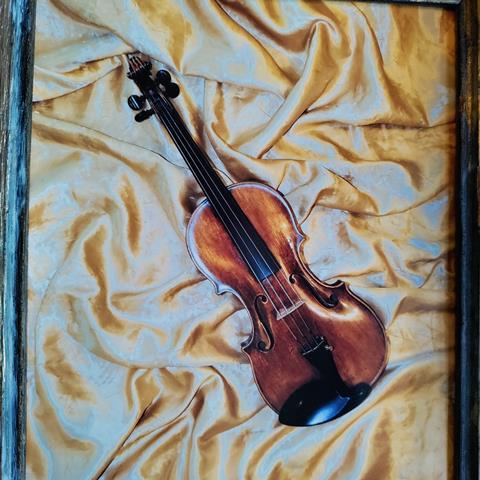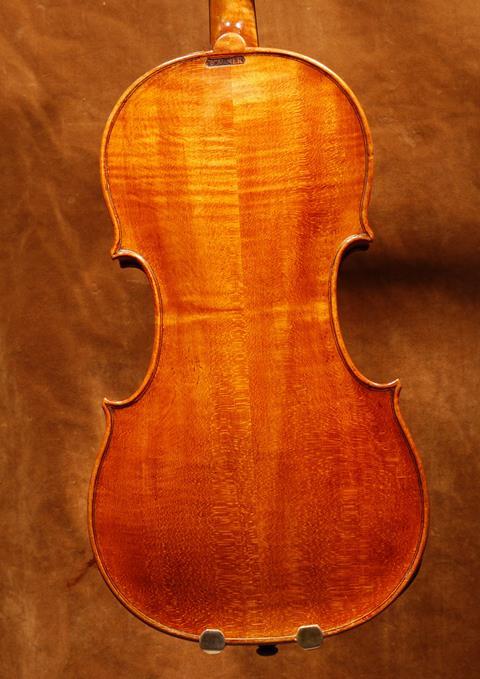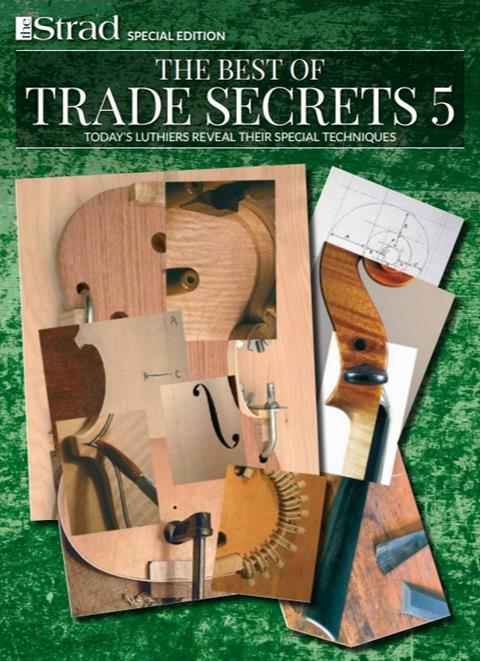Having explored the Violins of Hope exhibition, where instruments bear the legacy and scars of the Holocaust and World War II, violinist Barbara Khristi delves into the history of her instrument, Mrs. Evans. Surprised by the results, she shares her journey in this article

Discover more lutherie articles here
While music delivers living history and legacies, so, too, do instruments. I witnessed this up close and personal with the Violins of Hope, the international exhibition born of the luthiers Amnon Weinstein and his son, Avshi. Violins, a viola and a cello in the collection bear the legacy and scars of the Holocaust of World War II. Their ghosts are living on in the wood. Violin virtuoso Janine Jansen remarked in her video, Falling for Stradivari, that she could sense the souls of the musicians who owned the violins she was playing. Others have observed the same experience, as I also did when I was given the opportunity to play several of the violins in this collection.
Each instrument tells a story. Some instruments in the collection have been restored to performance condition. Some showed irreparable damages from being played outdoors in rain, snow, bitter cold and heat. In one case, a violin was buried in a garden for decades yet has been restored to playable condition. Their stories are published in James Grymes’ book titled Violins of Hope. The agonising details sometimes made me throw the book to the floor. But then I would pick it up and resume my heady and difficult education.
For me, it got personal, starting when I volunteered to give tours through the exhibition while it was in my hometown of Pittsburgh, Pennsylvania. My awakening grew over the course of two months. First, my awareness of the Holocaust was heightened during the first training session. Then, I realised that all of my violin and viola teachers were Jewish; from the Hungarian immigrant of 1920, Eugene Reichenfeld, to the lauded Juilliard viola teacher, William Linzer. Reichenfeld facilitated the purchase of my violin; Linzer sent me to the luthier who knows both my violin and my viola as one knows friends. So begins my legacy and the tale of my violin, and its legacy.
Putting the pieces together, the history of my violin was a puzzle. I had some framework, but the middle needed to be sorted out. It was after returning from 20 years of living in New York to live in Pittsburgh that I decided to return to playing violin from playing viola. In an effort to polish my violin anew, I ruined the finish. It was the luthier who restored my violin, Phillip Injeian, who told me it was not a Ruggieri. Instead, it was a good German violin. I was deeply disappointed. I had developed a belief that I had come upon a precious Ruggieri because of the label; even more so because of interest to see inside the violin by some who auditioned me.
In the course of training to be a docent this past September, I learned that German-made violins were often of comparable quality to fine Italian violins. Their lacklustre market was simply because of preferences for the French and Italian makers, and the growing aspects of anti-German feelings among the Jewish population.
German-made violins were rejected by Jewish musicians before, during, and after World War II. For that reason false labels were put inside these violins in order to sell them to musicians who otherwise would not buy them. I remembered learning that my violin, with a Ruggieri label dated 1643, was found to be a German-made violin. Maybe my violin was of the high quality mentioned in Grymes’ book.
This brought a desire to investigate my violin’s history. 20 years after learning my violin was German made, I looked at how my violin came to be mine. It was 1966, I was twelve. My teacher said I needed a good violin. He had set up a meeting at the owner’s home because the old man who owned it required that I audition for him. The reason for this was that he wanted someone to have it who would be serious about playing. This violin had belonged to his wife who had passed away, Mrs. Evans. So, I named the violin after her. He told me that she played first violin in the symphony. Doing the math proved that the time period of her playing would have been during and/or following WWII. She had played well enough to play first violin, and she had the violin as she reached old age like her husband.
Watch: John Dilworth repairs a violin that survived the Holocaust
Read: ‘Music was their lifeline’: Excerpt from Janet Horvath’s new Holocaust memoir
Soon after getting Mrs. Evans, I auditioned for the Pittsburgh Youth Symphony: for Mrs. Marie Maazel who was the manager (and mother of Lorin Maazel), and conductor Philip Spurgeon. They both wanted to see my violin. They looked inside. I understood this to indicate that it sounded good to them. This happened other times over the years.
Ruggieri was the label inside and it was dated 1643, Cremona, so I believed him to be the maker. Indeed, I must have a famous Italian maker’s violin! That would be why it sounds good. So, it took a while for me to accept that it was not Ruggieri.
A few short weeks later, we docents were given a private tour by luthier Avshi Weintstein before the exhibition opened. He was approachable so I told him the tale of my violin, Mrs. Evans. I was floored by his remark that Ruggieri was a label found in these German violins. This would identify my violin within the context of WWII where German-made violins were sold with false labels.
More pieces fell into place. As I walked through the exhibition time after time, myself now giving the tours, I noticed something about a violin that was made by Benedict Wagner. It was not the red, orange or yellow colours of other violins. In fact, it was golden brown, just like my Mrs. Evans. And it was a superior quality violin by a German maker.
Well, I haven’t had Mrs. Evans in my possession since about 2015 as I had retired from playing professionally. My granddaughter in Los Angeles had begun playing at a professional level, and she needed a good violin, so I gave it to her. But I do have a photo portrait of Mrs. Evans. I took the photo to the exhibit and held it up to the Wagner in the case. I was wowed. It was the same colour. It had a similar grain in the wood.
I needed to be sure I wasn’t projecting my newfound knowledge of other German made violins onto my violin. And so, I gave a private tour of the exhibit to Phillip Injeian, the luthier who had told me it was a good German violin. He knows my violin personally. I held up the photo for him to assess the two violins’ similarities. He told me it was the same wood, same period and made in the same region. They could be sisters. I was speechless.
The final test came after meeting up with Avshi at the closing reception of the two months long exhibition. I relayed the experience I had. He told me to send him a profile picture of the scroll as that would be a unique part of the violin maker’s signature. Just to be sure, Avshi asked me if it had a burn mark. When he sent me a photo of a brand burn mark that says ’Wagner,’ I saw that my violin was not branded a Wagner, as close as it may be in other regards.

Learning that my violin was not a Ruggieri, and not a Wagner, was not the benefit I came away with. Learning the history my violin lived through, realising that I am merely one chapter in its history, knowing that its history will continue with my granddaughter, and hopefully far into the future – this is the benefit I have come away with. And I now know that Mrs. Evans is a German violin, and it is truly a good German violin.
What is the greater story of your violin? What other souls can be sensed when you play it, knowing their legacy? Investigate the history of your precious instruments. It can only help deepen the quality of your performance.
Mother and grandmother Barbara Khristi is a retired violinist and lifelong philosopher based in Pittsburgh, Pennsylvania, US. She studied violin and viola at Duquesne University and The Juilliard School, Philosophy at Chatham University (BA) and Theology at Pittsburgh Theological Seminary (MA).
All photos courtesy Barbara Khristi
Read: Israeli Holocaust violin restorer receives award for service
Read: Book review: Violins and Hope: From the Holocaust to Symphony Hall
Read: Violins of Hope Richmond to showcase restored violins owned by Jewish musicians in the Holocaust
An exclusive range of instrument making posters, books, calendars and information products published by and directly for sale from The Strad.
The Strad’s exclusive instrument posters, most with actual-size photos depicting every nuance of the instrument. Our posters are used by luthiers across the world as models for their own instruments, thanks to the detailed outlines and measurements on the back.
The number one source for a range of books covering making and stinged instruments with commentaries from today’s top instrument experts.
American collector David L. Fulton amassed one of the 20th century’s finest collections of stringed instruments. This year’s calendar pays tribute to some of these priceless treasures, including Yehudi Menuhin’s celebrated ‘Lord Wilton’ Guarneri, the Carlo Bergonzi once played by Fritz Kreisler, and four instruments by Antonio Stradivari.






































No comments yet